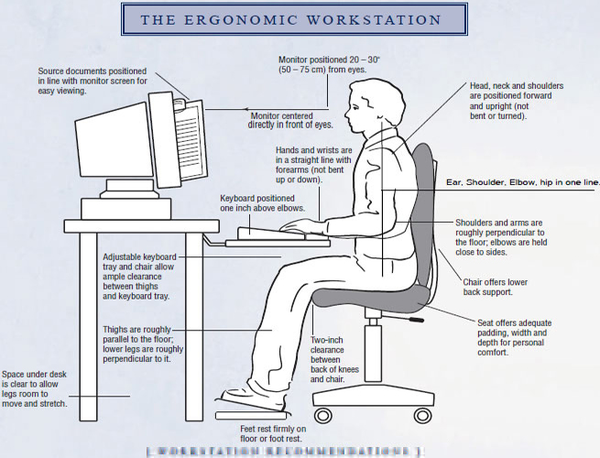
As technology has evolved, we are now spending more time than ever in front of screens, be they smartphones, computers or tablets. Recent research has found Americans spend about five hours every day on their smartphones… That’s more than 1,800 hours per year!
When we’re busy checking our emails, texts or social media activity, we’re forcing our heads and necks forward to look at our devices and probably don’t even realize it’s happening. Doctors have come to describe this as “tech neck.”
Tech neck (sometimes referred to as text neck) is a new name for an old problem. It is essentially neck pain that is a result of repetitive strain placed on the cervical spine. So if you want to understand how tech neck can impact your health, then you should learn more about where it all starts: the cervical spine.
The Cervical Spine
“Cervical spine” is the technical name for the neck. It is comprised of seven vertebrae and is the most flexible part of the spine. This is what allows our heads to move freely up, down, and side to side.
The cervical spine also has a natural curvature that bends inward at the neck. This is what helps to even out the backward curve of the thoracic spine, and is also what helps evenly balance the weight of the head.
Consider that the average adult head weighs 10-12 pounds. Even if you lean your neck forward just 15 degrees to look at your phone (for example), that doubles the weight of your head.
If you tilt your head forward and look down (the most common posture for staring at our smartphones) then the weight of your head is placing a whopping 50 to 60 pounds of force on the neck!
Because the cervical spine is highly flexible, it is also more susceptible to pain and even damage. Our necks were not built to withstand that type of force for extended periods of time. The result is often muscular strain that causes the symptoms associated with tech neck.
Symptoms of Tech Neck
So how do you know if you are suffering from tech neck? Symptoms are typically mild in the initial phases and then worsen as the condition progresses. Some of the most frequently reported symptoms are ones that include:
- Aches or stiffness in the neck shoulders, or upper back
- Pain when tilting the head forward
- Headaches or jaw pain
- Numbness and tingling pain in the arms and hands
- Poor posture due to muscle weakness
Pain can typically build over time and may disappear after several days or weeks. Alternatively, it may sporadically leave and return over the course of many years. A stiff or sore neck could spread into your mid-back and shoulder blades or into your arms.
The pain could be sharp at times or it could just be a dull ache. You may experience it when you’re using your phone or tablet, or it might bother you as you try to sleep at night. Whatever the case, if ignored or untreated, the pain will eventually become a distraction and negatively impact daily life.
Let’s take a look at some of the issues that can occur as a result of ignoring the symptoms of tech neck!
STRAIN ON THE NECK

Working on the computer or staring at a smartphone all day can cause extra strain on the neck. The muscles at the back of your neck will begin to stretch out as a result of a forward head, and the muscles in the front will then shorten. This is the place most of us hold our stress, and it can result in neck discomfort, soreness, and eventually pain.
SHOULDER PAIN
In addition to the pain in your neck from tech neck, one might also experience shoulder pain. Because smartphone screens are small, most of us tend to hunch our shoulders in order to hold the phone with one hand so we can text with the other.
Incorrect ergonomics when sitting at the computer can also cause us to hunch over the keyboard. In order to counteract this position to avoid potential shoulder pain, it is a good idea to give your shoulders a break periodically by stretching them out. Shoulder rolls are also a good exercise that can help with this.
UPPER BACK AND NECK PROBLEMS
As your posture worsens, the muscles in the upper back will start to stretch, resulting in the muscles in the front of your body getting weaker. Your neck then gradually moves forward which, as mentioned above, creates extra strain due to the increased force created by your heavier head. The outcome of this can ultimately be fairly severe structural back and neck problems.
HEADACHES
Headaches are another common problem that result from tech neck. This can happen, either from having your head forward too far while trying to look at a computer monitor, or from tilting your head down to look at your smartphone. Either of these positions result in an extra pressure on your neck from your head and could cause headaches
Instead of stretching out your neck when looking at your screens, try holding your phone at eye level. When at the computer, adjust your chair so that you are sitting upright and adjust your computer monitor so that it is at eye level, too.
SPINAL DEGENERATION OR CURVATURE
The more time we spend on handheld electronic devices, the more it can create long-term postural health issues. This is from the head-down posture that we default to when staring at our screens.
This posture can cause wear and tear on the cervical spine as well as degeneration, which can potentially lead to the need for spinal surgery. Constantly bending forward can cause you to develop the hunch-backed appearance that we sometimes see in older individuals, and that can become permanent.
These are just some of the problems that can arise from tech neck, so you can see that it is important to get ahead of it (pun intended!) to make sure that these issues do not develop in the first place.
Luckily, there are some things you can do to help prevent tech neck, as well as some exercises you can work on if you are already starting to show some of the symptoms.
What Can You Do About Tech Neck?
Since we rely on our computer and phone screens so often, it is easy to get lost in texting, playing online games, or working. In doing so, it is no surprise that we are not thinking about our posture and how it is being affected.
If you’re spending prolonged periods in the classic tech neck position, you’ll have to spend at least the same amount of time in the opposite position. So what are some ways that we can do this?
1. RAISE YOUR SCREENS HIGHER
To keep from tilting your neck down or forcing your head forward, hold your phone up close to eye level. If that causes your arms to become tired, you can buy a holder that elevates your phone.

There are similar devices that work with a computer monitor or laptop that will allow you to adjust their height so that they too are at eye level.
2. USE A CHAIR WITH A HEADREST
Your chair’s ergonomics can aid in proper posture and preventing tech neck. Get a chair with a headrest which will help to hold the back of your head up while you are using your computer. When you have your head back in that position, it can keep you from craning your neck forward to look down.
3. MOVE, MOVE, MOVE!
Our bodies were not designed to be sedentary all day. Although our modern lifestyle has evolved a long way from that of our hunter-gatherer past, our bodies have not. We should still be moving as often, and in as varied ways, as possible.
Stand up and walk around to get your blood circulating and to help put your neck in a different position, even if it is just for a minute. Walk up and down the stairs a few times. Stretch. Do a set of push-ups or squats. Do anything but continue sitting or standing in the same place.
Moving frequently benefits not only your neck, but it’s also good for your entire body. When you can, limit your screen time. Take breaks for a couple of minutes, especially when working. This can help you avoid neck pain in the first place.
Set an alarm to remind you to take a break. Research has found that we can only concentrate for about 20 minutes at a time, so I recommend getting up and moving every 20 minutes if possible. Try stretching or walking around during this time to counteract the tech neck position.
Also, do some aerobic exercise daily if you can. Examples of aerobic exercise are jogging, walking at a brisk pace, swimming, or using an elliptical trainer, treadmill, or stationary bike. You want to make sure that you choose an exercise that does not cause neck pain while you’re doing it or that causes issues the following day.
You can keep your neck and back healthier and stronger by exercising for at least 20 minutes three or four times a week. This will increase your respiratory and heart rates, help you work up a sweat, and ease neck tension.
4. STRETCH AND STRENGTHEN
As time progresses, you can develop muscle imbalances that can occur once you have a long-term forward-head posture. You can help to alleviate these imbalances by stretching and strengthening your neck, chest and upper back muscles. This can also help to minimize strain on the cervical spine (and support your head’s weight) by keeping these muscles in good shape.
Doing exercises that focus on the lower back and core muscles can also be useful. Why focus on this area of the body instead of the neck, shoulders, and upper back? Because these muscles are important when it comes to supporting your upper body, including your neck.
Some suggested stretches to counteract the effects of tech neck are as follows:
Chin Tuck
While sitting in a chair, clasp your hands together behind your head while grounding your hips into your seat. Tuck your chin in toward your chest and at the same time use your hands to gently pull your head down. You should feel a stretch in the back of your neck and upper back. Hold 20 to 30 seconds, then slowly release. Repeat this a few times.
Scapular Retractions
Stand against a wall with your eyes facing forward and your shoulders pulled back and down from your ears. Without letting your shoulders raise, squeeze your shoulder blades together behind you, then relax them. Repeat this 20-30 times
Standing Overhead Extension
Stand with your feet pointing straight and hip-width distance apart. Interlace your fingers together and stretch your arms over your head, pressing your hands to the ceiling with palms up. Keep your arms straight, do not bend at the elbows. Do not lean back.
Attempt to keep your arms directly overhead, not forward of your head. Maintain a neutral spine and tight stomach while keeping your .Shoulders down and away from ears. Hold this position for one minute.
Standing Chest Lift
While standing, interlace your hands together and place then on the back of your head so that you are palming your skull. Gently press your head back into your hands and while keeping your eyes forward, bend your upper torso slightly back. Hold for 30 seconds and repeat a few times.
Avoid tilting your pelvis instead of moving upper-middle back. The key is to have your breastbone lift up and back while keeping your pelvis neutral.
5. SEEK PROFESSIONAL HELP
Pain is your body’s signal that something is wrong. Think of it as your “check engine” light. There could be a more severe problem occurring, so pay attention to your pain and act quickly by reducing any head-forward posture or strain on your neck to the best of your ability.
If you are not sure what proper posture should look like, you can read my Check Your Body’s Alignment blog. This will give you an idea if you already have a forward head, which can result in tech neck.
While the exercises listed above are a good place to start, they are by no means meant to be comprehensive. Everyone’s body is different and everyone’s posture is unique. For this reason, it is best to receive customized exercises that address your specific needs and imbalances.
If you are interested to see if posture therapy can help with tech neck, or any other chronic pain issues you may have, please contact Pain Free Philly or schedule a free consultation.
With our help, you can get back to a life that moves you!
